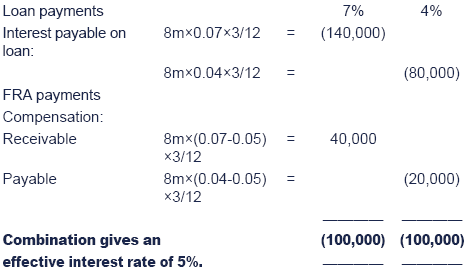Forward Rate Agreements (FRAs)
Forward Rate Agreements (FRAs) are a tool for hedging interest rate risk.
Characteristics
An FRA is an agreement on interest rates relating to a notional loan or deposit. The loan or deposit is for a stated period, such as two months, three months, six months and so on, starting at a specified time in the future.
In the terminology of the markets, an FRA on a notional three-month loan/deposit starting in five months time is called a "5-8 FRA" (or "5v8 FRA").
When an FRA reaches its settlement date (usually the start of the notional loan or deposit period), the buyer and seller must settle the contract:
Hedging using FRAs
Hedging is achieved by a combination of an FRA with the "normal" loan or deposit.
Borrowing (hence concerned about interest rate rises)
- The firm will borrow the required sum on the target date and will thus contract at the market interest rate on that date.
- Separately the firm will buy a matching FRA from a bank or other market maker and thus receive compensation if rates rise.
Depositing (hence concerned about a fall in interest rates)
- The firm will deposit the required sum on the target date and will thus contract at the market interest rate on that date.
- Separately the firm will sell a matching FRA to a bank or other market maker and thus receive compensation if rates fall.
In each case this combination effectively fixes the rate.
Illustration
Enfield Inc's financial projections show an expected cash deficit in two months time of $8m, which will last for approximately three months.
It is now the 1st November 20X6. The treasurer is concerned that interest rates may rise before the 1st January 20X7. Protection is thus required for two months.
The treasurer can lock into an interest rate today for a future loan.
- The company takes out a loan as normal, i.e. the rate it pays is the going market rate at the date the loan is taken out.
- It will then receive or pay compensation under the separate forward rate agreement to return to the locked-in rate.
Suppose a 2 v 5 FRA at 5.00 - 4.70 is agreed.
- The agreement starts in 2 months' time and ends in 5 months' time.
- The FRA is quoted as interest rates for borrowing and lending - the borrowing rate is always the highest.
Calculate the interest payable if in two months' time if the market rate is: (a) 7% or (b) 4%.
Solution

- In this case the company is protected from a rise in interest rates but is not able to benefit from a fall in interest rates - a FRA hedges the company against both an adverse movement and a favourable movement.
- The FRA is a totally separate contractual agreement from the loan itself and could be arranged with a completely different bank.
- FRAs are usually on amounts > $1m and enable you to hedge for a period of one month up to two years. However, as an over the counter instrument, they can be tailor-made to the company's precise requirements.
|
Created at 9/12/2012 3:25 PM by System Account
(GMT) Greenwich Mean Time : Dublin, Edinburgh, Lisbon, London
|
Last modified at 11/13/2012 8:13 AM by System Account
(GMT) Greenwich Mean Time : Dublin, Edinburgh, Lisbon, London
|
|
|
|
 |
Rating
:
|
 Ratings & Comments
(Click the stars to rate the page) Ratings & Comments
(Click the stars to rate the page)
|
 |
Tags:
|
|
|
|
|